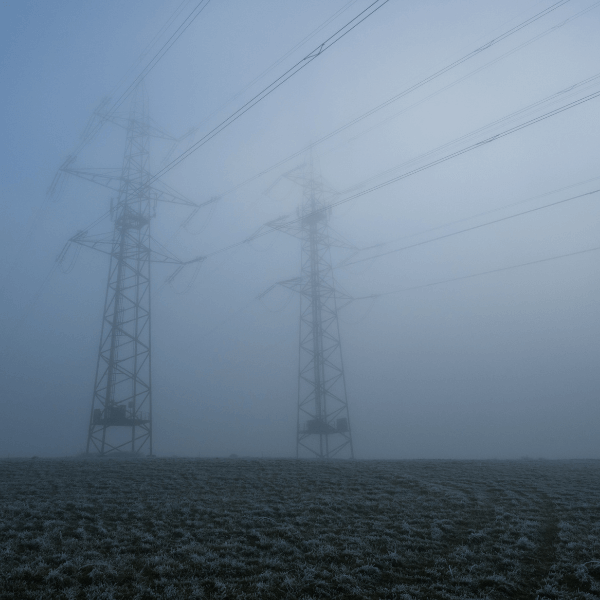
Overhead Power Lines in Construction
According to the law--specifically the Electricity at Work Regulations 1989--any work carried out near overhead power lines must be carefully planned to avoid contact with the electricity supply.
Contact with overhead lines can cause injury or fatalities to those affected, damage to structures, and disruption to the electricity supply to local towns and businesses.
There must be safe clearance between newly constructed buildings under or adjacent to overhead power lines, too. Lines may need to be rerouted or constructed to adapt to new construction, or to minimise risk to workers temporarily. Ideally, however, construction near overhead power lines should be avoided where possible.
Work involving MEWPs, scaffolding, cranes, and other work at height equipment is particularly risky.
Work needs to be planned and executed with overhead lines in mind. Precautions will depend on the nature of the site, but because electricity is dangerous and because overhead lines can supply vital power to entire towns, even very short-term work of minimal risk should still be analysed.
The Electricity at Work Regulations 1989
It is stated in the law that it is the duty of the employer or those who are self-employed to comply with the regulations and ensure they are followed in any work they are in control of. Construction employees also have a duty to cooperate with their employers and comply with the regulations which are within their control.
You must plan and prepare the work, eliminate the danger, control access, and control the work.
The risks of electricity should be understood by anyone working near electricity. Closeness to overhead lines is enough for 'flashover'; contact isn't necessary. Electrical current can still be conducted through wood or plastic, and you must not confuse overhead power lines with telephone lines or other lines.
What You Need To Do
Plan & Prepare
Before any work is carried out on site, there must be a plan in place. Assess all of the risks, including if there are risks from overhead power lines. You need to identify those which are on your site and nearby. Remember that lines off-site could still be affected by tall machinery and MEWP equipment.
Always assume power lines are live unless proved otherwise by the suppliers. Lines can often be made dead or diverted by the electricity company, but you need to leave sufficient time for this to occur, which may delay your project.
Eliminate the Danger
The best way to eliminate danger is to avoid working in areas with overhead power lines. But, this isn't always possible.
So, you need to contact the local electricity supplier to divert the lines clear of the work area, or isolate them (cut the power while work is being carried out).
Remember that as well as homes and businesses, an overhead electricity line can also supply electricity to a railway or tramway power line.
If possible, try to avoid work being carried out which will cause disruption. If neither avoidance, isolation or diversion are possible, particularly with long-term or permanent worksites, do the below:
Control Access
Access to the site should always be limited or monitored for security reasons, but it is particularly vital when there are electricity lines. Define passageways, and clear the area around overhead lines.
You may have to limit areas where tall vehicles and tall objects can be taken. This includes MEWPs, delivery vehicles, and items such as scaffold poles or ladders. Everything should be able to safely pass under the lines with no risk of touching them.
Items could need to be adjusted, or delivered unbuilt.
Be Aware of Exclusions
Anything too tall to be taken under the wires needs to be taken around the site. Know the maximum height of any plant machinery and materials--this should be a really safe guide, leaving plenty of space as opposed to only just missing the wires. You should know where the wires are, and how tall they are too. Put plans in place for anything which is too tall or cannot be taken through the defined passageways.
As a general rule, you should not get within 6 metres of a power line, but your power line supplier will be able to give you more specific guidance.
Ensure signs and barriers are in place, so the presence of lines can't be missed. Anyone who is tired, rushing, or tempted to cut corners should be stopped. Visibility of lines should be clear in foggy and dull conditions, and in sheltered areas such as woodland. Barriers and signs will be essential.

Put Supervisions In Place
Plant and materials access and work being carried out should be under the direct supervision of a suitable person appointed to ensure that safety precautions are observed.
Types of Electricity Overhead Wires
Most overhead wires will be supported by either metal pylons or wooden poles. You may see them referred to as transmission lines.
Generally, the higher the voltage, the higher the wires must be off the ground. This does not mean low voltage = lesser injury, however. Impact can still be severe.
- 2024
- 2023
- December 2023 (13)
- November 2023 (9)
- October 2023 (7)
- September 2023 (10)
- August 2023 (20)
- July 2023 (21)
- June 2023 (17)
- May 2023 (17)
- April 2023 (17)
- March 2023 (14)
- February 2023 (15)
- January 2023 (7)
- 2022
- December 2022 (6)
- November 2022 (12)
- October 2022 (24)
- September 2022 (14)
- August 2022 (12)
- July 2022 (15)
- June 2022 (18)
- May 2022 (14)
- April 2022 (9)
- March 2022 (5)
- February 2022 (5)
- January 2022 (2)
- 2021
- December 2021 (7)
- November 2021 (10)
- October 2021 (1)
- September 2021 (1)
- August 2021 (3)
- July 2021 (3)
- June 2021 (4)
- May 2021 (1)
- April 2021 (1)
- March 2021 (2)
- February 2021 (1)
- January 2021 (1)
- 2020
- 2019
- 2017
- 2016
- 2014
- 2013
- 2012
- 2011


